
Intro: What is website siloing?
Siloing a website refers to organising your content in such a way that articles on similar topics are grouped together in a hierarchical structure.
These articles are grouped together in three ways:
By navigational structure:
Rather than having every page on a website accessible from the home page, your home page directly links to broader-level topic pages (called “parent pages” within this article) which then have internal links to subtopic pages (called “child pages” in this article.) Parent pages act as folders for child pages, making your site easy to navigate for users.
By URL structure:
URLs take the structure: “url.com/parent-page/child-page”. This allows you to have as keyword rich a URL as possible and makes it clear to search engines the role that a page plays in your website as a whole.
By internal links:
Parent and child pages are interlinked within a silo allowing for link equity to be passed around as efficiently as possible.
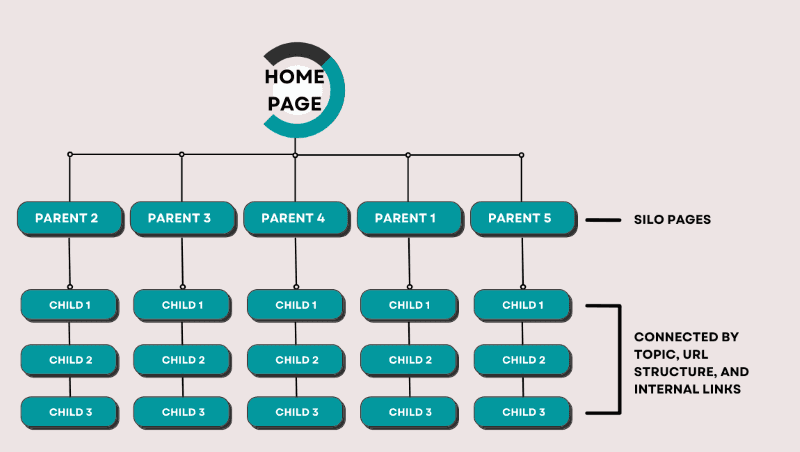
The end goal of our siloed website is to have our content organised in a hierarchical structure, much like how we organise the documents on our computer in relevant folders.
Why silo an affiliate website?
Since affiliate websites are often bootstrapped, we want to make sure that the resources that we put into them are being used as efficiently as possible.
Building your website in a silo structure ensures that none of your site’s content and links are wasted. It maximises the utility of your website’s content and links in four ways, which we will go through now.
Siloing your website maximises its crawlability
By having each page on our website belong to a higher-level parent page, and joining these pages through both URL structure and internal links, we make sure that each page is as easy as possible for search engines to crawl and index.
This minimises the likelihood of technical issues like orphan pages occuring, meaning that you will not waste time and money building out pages that will never bring in organic traffic because they have not been indexed by search engines.
A silo structure maximises your topical authority
Over the last few years larger publishers have woken up to the money that can be made by ranking for affiliate keywords and are leveraging their huge authority to displace smaller affiliate sites in these SERPs.
The All-in-One Platform for Effective SEO
Behind every successful business is a strong SEO campaign. But with countless optimization tools and techniques out there to choose from, it can be hard to know where to start. Well, fear no more, cause I've got just the thing to help. Presenting the Ranktracker all-in-one platform for effective SEO
We have finally opened registration to Ranktracker absolutely free!
Create a free accountOr Sign in using your credentials
Smaller sites therefore need to be seen as having highly specialised knowledge on a narrow topic to compete with these big publications on keywords related to that topic.
If we look at the SERP below for the affiliate keyword: “best toaster for sourdough bread”, we can see that the first page of Google is taken up by either large magazines, or sites that specialise in toasters and fermented foods respectively.
![]()
Since building a site in a siloed structure forces you to organise your content around certain topics, it allows you to build authority on specific topics as quickly as possible. Articles within a silo support each other in building this topical authority.
This means that if you silo your affiliate site, and concentrate on building out one silo at a time, you should be able to compete in competitive affiliate SERPS (ones where large publishers have entered the market) faster than if you were to build your site in a less structured way.
Siloing your site allows you to funnel link equity as efficiently as possible
One of the main reasons why you silo your site is to reduce the number of pages that you have to build links to.
If your site is siloed out, you can often get away with just building links to the parent pages in your website. These will funnel link equity to your child pages by virtue of the fact that they have internal links pointing to each of these child pages.
The All-in-One Platform for Effective SEO
Behind every successful business is a strong SEO campaign. But with countless optimization tools and techniques out there to choose from, it can be hard to know where to start. Well, fear no more, cause I've got just the thing to help. Presenting the Ranktracker all-in-one platform for effective SEO
We have finally opened registration to Ranktracker absolutely free!
Create a free accountOr Sign in using your credentials
Once your silo is built out and you have built some links to that silo’s parent page, you can then build links to the child pages depending on where they are ranking for their target keyword and the links that their keyword competitors have.
Getting these initial links to your parent pages and assessing child page rankings at this point means that you have much more accurate data on how many links you actually need to rank each page, meaning that you do not waste money on building unnecessary links.
Siloing your site increases its navigability for the user
Organising your website into silos makes it far easier for users to find what they are looking for when on your website.
This should increase the amount of money that you make from each user on your website, as well as increasing user engagement metrics which can have a positive impact on rankings.
As maintaining a clean silo structure gets more difficult the larger a site grows, smaller websites can make up for a relative lack of authority by having their site structured in such a way that what topical authority and link equity they do have is maximised as far as is possible.
How to silo an affiliate website
Now we’ve looked at why you want to build your affiliate site around silos, we are now going to look at how to do this
For the purposes of this explanation we are going to assume that you are starting your site from scratch. Building out silos from an established website is much more complicated than building them on a new website as the former involves changing a site’s URL structure which can lead to a whole host of technical problems.
We are going to be using the example of an affiliate site in the coffee niche to explain how to build out silo structures. Since the point of silos is to structure your content semantically, the broader categories that you can use to group articles together will vary from niche to niche. You therefore do want a bit of knowledge of the niche that you are working in to determine what the most sensible silo categories are for your site.
Step 1: Keyword research
We should always start with keyword research and build our silos out of the low competition keywords that we find, and not the other way around.
This is because no matter how well we organise our site, until we have built up authority through link building we will only be able to rank for extremely low competition keywords.
For an affiliate site, our keyword research will usually involve trying to find keywords that:
- Refer to high ticket products in our nice (for the coffee niche this will often by coffee machines)
- That signifies purchase intent (often this will be keywords like “best PRODUCT”, “PRODUCT x vs PRODUCT y”, “PRODUCT alternatives” and “is PRODUCT worth the money”.
The one factor about siloing that you want to bear in mind during keyword research is that each silo category should have a minimum of 8 pieces of content to build out topical authority.
Therefore if you find a low competition keyword around a specific product, you should try and comb as far as you can through all the relevant affiliate keywords around that product to try and build out a potential silo.
For example, let's say you have found the low-competition affiliate keyword: “best nespresso machines for lattes”. The obvious higher level “parent” category here would be nespresso machines, so you want to try and find all the low-competition affiliate keywords that mention this product in order to build out a silo around it.
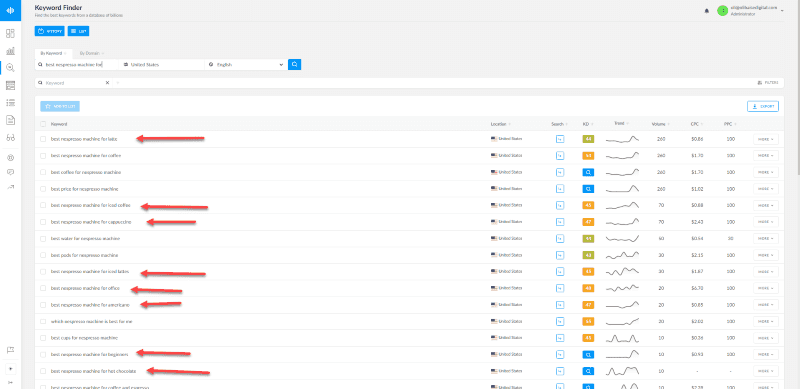 (An example of some of the keywords you could use for child pages in your nespresso machine silo)
(An example of some of the keywords you could use for child pages in your nespresso machine silo)
It's worth noting that this is actually a useful framework for product-based keyword research regardless of whether you are building out silos. Buyer-intent keywords around a certain product tend to have a similar level of competition. Therefore if you find one low competition keyword around a certain product, it's very likely that you will be able to find several of them.
While you are filling out your spreadsheet with keywords, you should have a column that ascribes a broader parent category to each keyword. Although this does not have to be your final silos it should give you a starting idea of what your silos will be based on where the low competition non-commercial keywords are in your niche.
Step 2: Planning out your silos
Once you have a list of keywords that you think your site can rank for given its current level of authority, the next step is to categorise these into silos.
Since siloing your keywords involves putting them into a hierarchical structure, you’ll benefit from using a tool that allows you to organise information in hierarchies. I like to use dynalist.io for this, partially because it's free but also because it allows an infinite number of indentations and collapsible hierarchies.
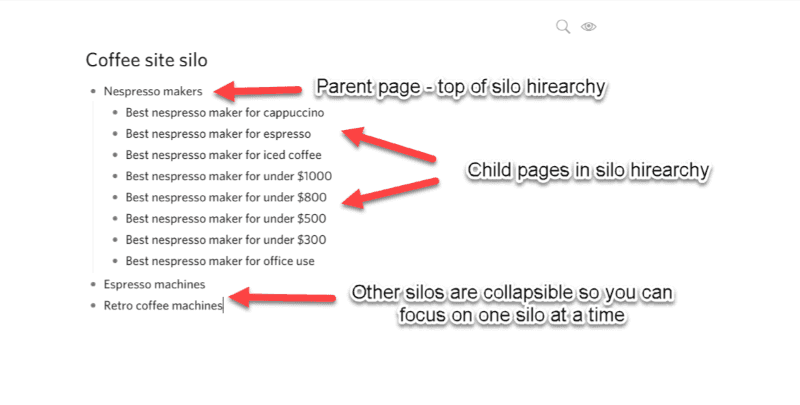
Planning out your silo involves three key steps, they are:
- Selecting your silo parent topics
- Assigning child pages into a silo
- Selecting a silo to start working on
Selecting your silo parent topics
When selecting silo topics we want to remember that one of our aims with our site structure is to build authority around a specific topic.
Therefore you want silo parent topics that are:
- On topics that are lucrative enough to be worth developing authority on
- Are discrete enough so that you have a decent breadth of topical authority once your various silos are built out
For the majority of affiliate sites, you will be building your silos around different product types.
With our coffee site, for example, we should be building silos around specialist machines for different types of coffee (nespresso, espresso, filter coffee etc) as they are the highest ticket products in our niche and each coffee type requires different types of machines. This means there will not be too much crossover between silos.
As a general rule of thumb, the more expensive the product that your silo is built around, the more fine grained you want your silo to be. This is because higher-ticket products are usually more competitive in the SERPs, and therefore require a higher level of specialised topical expertise to rank.
Going back to our coffee site example, this means that you might want to “silo down” espresso machines by brand or by price range. Cheaper products such as coffee grinders, mugs and presses, on the other hand, can be grouped together in a general “coffee accessories” silo.
Assigning child pages into a silo
For the majority of your child pages it should be obvious which silo they belong to. This is especially true of affiliate sites where silos are likely to be based on different product types.
Simply assign the child page to a silo based on whatever product is being featured on that page.
The only time where it might be unclear what silo to assign your child pages to is when they talk about more than one product type, and you have silos dedicated to each product type that is spoken about on that child page. This often happens with pages targeting product comparison keywords. For example, if we have a page targeting the keyword “nespresso machine vs espresso machine” and we have silos dedicated to nespresso and espresso machines, then it is not clear which silo this page belongs to.
In cases like this we should remember that a silo should have a minimum of 8 pages within it to build topical authority. Therefore we can choose what silo to add this page to depending on these needs.
If both silos have far more than these 8 pages then we should just add it to whichever one has fewer pages.
If you have any child page keywords that do not fit into a silo then put these aside for now. A new site will unlikely rank for keywords where it does not have topical authority so they should not be your priority.
Selecting a silo to start working on
You want to start working on whichever silo has the least competition. The more silos you have built out, the more authoritative your site will become, and this will then allow you to compete on more competitive silos.
Ranktracker’s keyword difficulty metric can help you to determine how competitive each silo will be. Simply take the average keyword difficulty of each keyword within a silo. The one with the lowest average difficulty should be the one you start with first.
Step 3: Creating your silos in WordPress
When creating our silos in WordPress we want to remember that silos are connected together through navigationational structure, URL structure and internal linking.
To get the correct navigational structure we want to make sure that all our top-level parent pages are accessible from the homepage of our website. The best way to do this is to add them as drop downs to the main menu of our site.
We can get the correct URL structure for our silos by using pages for all our pages (rather than posts) and using a parent/child structure. Every child page of your silo should be assigned its respective parent page. You can set these parent pages either in the “add new” tab of WordPress or in the “all pages” tab of WordPress if you use the Nested Pages plugin.
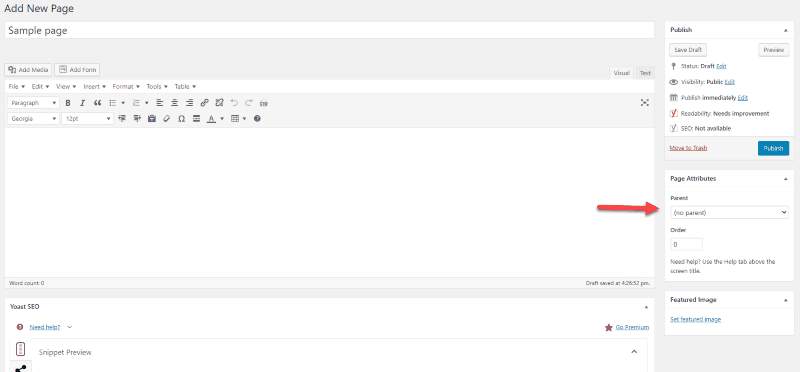 (Setting up a parent/child structure when adding a new page)
(Setting up a parent/child structure when adding a new page)
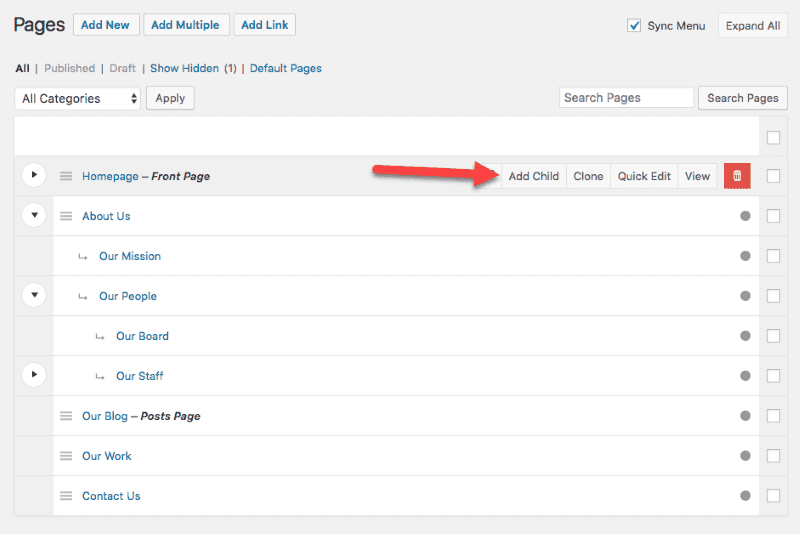 (Setting up a parent/child structure with the nested pages plugin. Image source: WordPress)
(Setting up a parent/child structure with the nested pages plugin. Image source: WordPress)
Step 4: Internal linking in a silo structure
We want to have as many internal links as we can within a silo to both increase our topical authority on the silo-topic and to pass equity from topic-relevant links around the silo.
Here are some rules to follow around internal linking and silo site structure.
- Parent pages should always link to every child page in a silo: If a parent page does not link to a child page then there is a strong chance that the child page will be orphaned and therefore go unindexed by search engines
- Every child page should link back to their parent page: We want our parent pages to be some of the strongest on our site in terms of link equity. Internal links from child pages should help with this
- Child pages within a silo should link to each other: Having internal links between child pages within a silo will further reinforce their relevance to each other and build topical authority on your site.
- Child pages should link across silos sparingly: Having a large amount of internal links across silos can diminish your sites topical authority.
Best practises for your silo structure
As your site gets larger, keeping a clean silo structure becomes more difficult. Here are some rules to keep in mind to keep your site well structured even as more content gets added to it.
Have a plan for your parent pages
Parent pages are more than just a category page to list your product pages. They will become some of your most powerful pages in terms of link equity and therefore can be used to target some of the top keywords in your niche.
Assuming that you have built your parent pages around a particular product, you will likely want to try and optimise the page for the keyword “best PRODUCT�”.
An example of this, again in the coffee niche, is Roasty Coffee’s Keurig coffee maker roundup post. The article itself is optimised for the high volume, high competition keyword: “best keurig coffee makers”, however the write-up every machine featured in the roundup links to an individual review of that machine. These individual reviews are the child pages in the silo.
This not only puts them in the running to rank for one of the most lucrative keywords in your niche, but it means that if they build links to this one page, all of their individual Keurig coffee maker reviews will benefit from this.
 (A parent page optimised for the keyword “best Keurig coffee makers”. Each entry in this roundup links to individual product reviews, the child pages in this silo)
(A parent page optimised for the keyword “best Keurig coffee makers”. Each entry in this roundup links to individual product reviews, the child pages in this silo)
While it may not be worth your time optimising your parent pages right off the bat (as you want to be chasing competitive keywords with them), you should have a plan for what keywords you will chase with these before you set up each silo.
Do not go more than 3 levels deep with your hierarchy
The deeper you go with your hierarchy, the harder your site gets to crawl, navigate, and the more link equity gets diluted from your parent pages.
The All-in-One Platform for Effective SEO
Behind every successful business is a strong SEO campaign. But with countless optimization tools and techniques out there to choose from, it can be hard to know where to start. Well, fear no more, cause I've got just the thing to help. Presenting the Ranktracker all-in-one platform for effective SEO
We have finally opened registration to Ranktracker absolutely free!
Create a free accountOr Sign in using your credentials
You therefore want to avoid building out silos that are more than three levels deep. As you are doing keyword research take note of how far your keywords in a silo can drill down with long-tail variations and plan your silos accordingly.
If you make a mistake with this with your initial keyword research, it's better to start a new silo rather than build on an existing one if the latter would make a silo more than three levels deep.
Your URL structure is final
Once a page goes live and becomes part of your wider site architecture, changing its URL can lead to broken internal links and the page in question losing its ranking. You therefore want to avoid changing pages’ URLs as much as possible.
Some ways that you can avoid this from happening include:
-
Do not publish child pages until they are finished being written: As you create a page you may realise that it is more relevant to a different silo from the one you first assigned it to. You should therefore keep the page in preview mode until it's finished so you can change what parent page it is assigned to before the URL goes live.
-
Check competitor’s silos when planning your own: Although you shouldn’t just copy your competitor’s silos, having a look at how your competitors structure their site can let you know if you are missing out any obvious categories.
-
If in doubt leave it out: If you are not sure about what your parent pages should be, or which silo your child pages should go, then just leave it for now and come back to it once you have built out other parts of your site. The more you get to know the industry you are working in the more you will understand how all its subtopics fit together.
Conclusion
Proper site siloing takes a bit of extra planning before you start publishing content, but if done correctly it should help your site punch above its weight in terms of the keywords that it can rank for.
There is no “correct” way of siloing a website and since the way you organise your content is something that you have to decide upon before you start publishing, there will always be a leap of faith involved with how you choose your silos. So long as the website is easy to navigate, and related topics are linked together by URL structure and internal links, you won’t go too far wrong.

